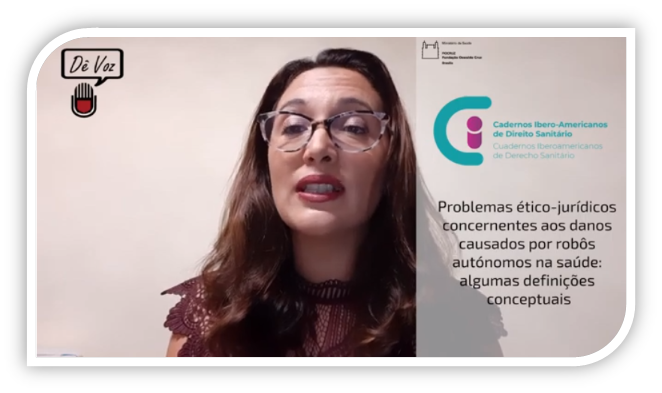Abstract
Objective: this article presents two of the most prominent normative problems on damage caused by autonomous robots in healthcare: what is considered autonomy when referring to the action of a robot, and what is considered damage in the activity of an autonomous robot. The aim is to contribute to the philosophical speculative understanding of the concepts of damage and autonomy in the broad critical thought about robots. Methodology: from an analysis of the most relevant literature and a prior conceptual definition, we discussed and defined fundamental notions about the problem of ethical programming in an integrated (ethical and legal) manner. Results: damage and autonomy are concepts frequently and uncritically used in the literature. However, living with autonomous robots requires reflection that considers the ethical agency of robots as opposed to humans. We have identified three principles as essential in the search for a conceptual consensus: respect for the refusal to be treated by a robot; the protection of human freedom in the face of a robot; and the maintenance of the social bond. Conclusion: the ethical programming of autonomous robots, far from being an abstract utilitarian exercise, requires a transdisciplinary, ethical-legal consensus that allows different categories of damage and autonomy to be covered.
References
Bensamoun A et al. Droit de l´Intelligence Artificielle. Issy-les-Moulineux: LGDJ Editions; 2019. p. 25.
Albert H. Treatise on Critical Reason. Princeton: Princeton University Press; 1985. p. 99.
Füller L. Morality of Law. Yale: Yale University Press; 1964. p. 186.
Reale M. Lições Preliminares de Direito. São Paulo: Editora Saraiva; 2001. p. 38.
Rodotà S. Il diritto di avere diritti. Milano: Laterza; 2012. p. 200.
Rodotà S. Il Corpo Giurdificato - Il Governo del Corpo. Milano: Gioffrè; 2011. p. 51-76.
Nie NH, Erbring L. Internet and society: A preliminary report. Stanford, CA: Stanford Institute for the Quantitative Study of Society. [Internet]. 2000 [acesso em 26-08-2020]. Disponível em: http://www.nomads.usp.br/documentos/textos/cultura_digital/tics_arq_urb/internet_society%20report.pdf.
Hogg M. Liability of Unknown Risks: A Common Law Perspective. 15th Annual Conference on Tort Law. Viena: ECTIL – European Centre of Tort and Insurance Law; 2016. p. 26-28.
Organização das Nações Unidas. Declaração Universal dos Direitos Humanos. Disponível em https://www.ohchr.org/EN/UDHR/Pages/Language.aspx?LangID=por.
Estrasburgo. Disposições de Direito Civil sobre Robótica. Resolução do Parlamento Europeu, de 16 de fevereiro de 2017, que 'contém recomendações à Comissão sobre disposições de Direito Civil sobre Robótica (2015/2103(INL)). Disponível em: https://www.europarl.europa.eu/doceo/document/TA-8-2017-0051_PT.html.
Mori M et al. The Uncanny Valley. IEEE Robotics & Automation Magazine. 2012; (19): 98-100.
Denton D. As Emoções Primordiais: A Emergência da Consciência. Lisboa: Instituto Piaget; 2010. p. 50.
Caudill DS. Lacan and Legal Language: Meanings in the Gaps, Gaps in the Meanings. Law and Critique. Liverpool: Deborah Charles Publications; 1992. p. 169.
Wilson EO. O Sentido da Vida Humana (Prémio Pulitzer). Lisboa: Clube do Autor; 2014. p. 107.
Sheridan T, Verplank WL. Human and Computer Control of Undersea Teleoperators. [Internet]. 1978 [acesso em 26-08-2020]. p. 8-15. Disponível em: https://www.researchgate.net/publication/23882567_Human_and_Computer_Control_of_Undersea_Teleoperators.
Yadav J et al. Intelligent Heart Rate Controller for Cardiac Pacemaker. [Internet]. 2013 [acesso em 26-08-2020]. p. 36. Disponível em: https://www.researchgate.net/publication/266010590_Intelligent_Heart_Rate_Controller_for_Cardiac_Pacemaker.
Russel S, Norvig P. Artificial Intelligence: A Modern Approach. 3.ª edição. New Jersey: Pearson; 2010. p. 610.
Hakli R, Seibt J. Sociality and Normativity for Robots: Philosophical Inquiries into Human-Robots Interaction. Switzerland: Springer; 2017.
Andersen M, Andersen SL. Machine Ethics. Cambridge: Cambridge University Press; 2011. p. 83.
Moor J. The Nature, Importance, and Difficulty of Machine Ethics. IEEE Inteligent Systems. 2006 (4): 18-21.
Andersen M, Andersen SL. Machine Ethics. Cambridge: Cambridge University Press; 2011. p. 7.
Moniz Pereira L, Saptawijaya A. Programming Machine Ethics. Switzerland: Springer; 2016. p. 109.
Goodall N. Machine Ethics and Automated Vehicles. Road Vehicle Automation. Switzerland: Springer; 2014. p. 93-102.
Swan M. Machine Ethics Interfaces: An Ethics of Perception of Nanocognition. In: Rethinking Machine Ethics in the Age of Ubiquitous Technology Information Science Reference; 2017. p. 97-150

This work is licensed under a Creative Commons Attribution-NonCommercial 4.0 International License.
Copyright (c) 2020 Ana Elisabete Farinha Ferreira Dias Pereira

